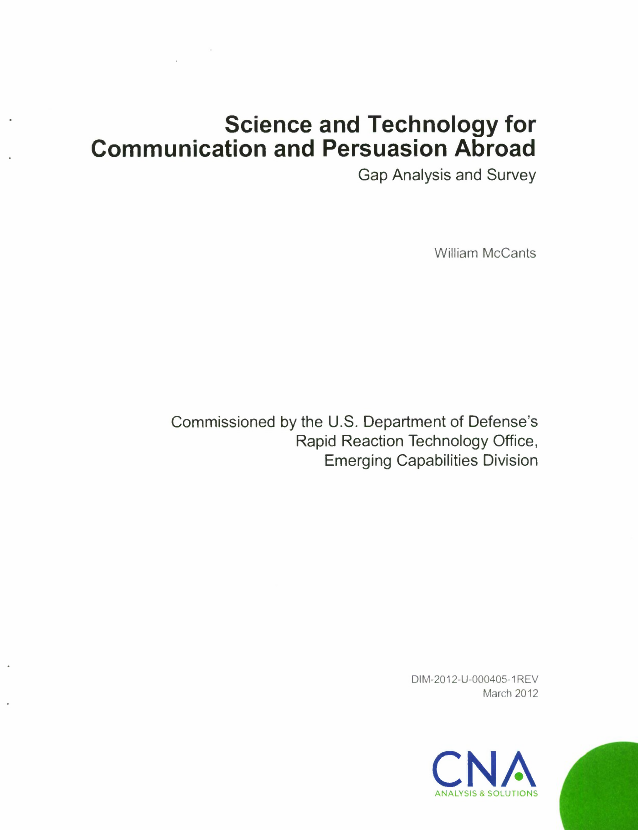Science and Technology for Communication and Persuasion Abroad Gap Analysis and Survey
- DoD Rapid Reaction Technology Office
- 33 pages
- March 2012
- 4.69 MB
Over the last 10 years, the U.S. government has made significant investments in science and technology in order to enhance its ability to understand and shape public opinion and behavior abroad—a domain of activity referred to in this report as “shaping,” “influencing,” or “communication and persuasion.” Because this effort is taking place across a vast government bureaucracy, the policy-makers and practitioners engaged in communication and persuasion do not always know what tools are at their disposal and what tools need to be invented.
To address this problem, the Department of Defense’s Rapid Reaction Technology Office (RRTO) issued a “Strategic Communication Science and Technology Plan” in 2009 that surveyed the government’s programs in this area and their gaps. To keep abreast of the latest technological developments, RRTO commissioned CNA to update this report for FY 2012. The updated report discusses domains for future investment in research and development (R&D); identifies gaps and proposes new science and technology (S&T) initiatives; and surveys current S&T programs.
There has not been adequate investment in the technological gaps identified by RRTO in 2009. Furthermore, the U.S. government has made limited R&D investments in using social interaction technology, persuasive technology, and immersive virtual environments and simulation games for communication and persuasion—areas of R&D not discussed at length in RRTO’s 2009 report. CNA reached this conclusion after surveying current U.S. government programs, reviewing recent academic literature on technology for communication and persuasion, and consulting with experts inside and outside the U.S. government. Based on an analysis of these gaps, we have identified the following areas for investment:
• Survey and validation of theories and techniques for influence in the digital realm
• Target audience analysis, trend monitoring, and source criticism
• Online measures of effectiveness
• Training in techniques of communication and persuasion in the digital realm
• Immersive virtual environments and simulation games for non-military purposes
• Persuasive technology on mobile devices for encouraging positive behavior
• Crowdsourcing for problem solving and accountability
• Studying adversary use of social media
• Technology for promoting freedom under repressive regimes
• Expanding investment in emerging technologiesAlthough these development, research, and training gaps have been listed separately, they are interdependent, as are the three technologies highlighted below: social interaction technology, persuasive technology, and immersive virtual environments and simulation games. Indeed, as the technologies converge on one another, it will become more difficult to speak of different domains of technological research and development for communication and persuasion.
As communication becomes more digital (i.e., mediated by computers), more interactive (enhancing an individual’s influence), and more mobile, those who understand the new communication environment and know how to use it effectively will have more influence than those who do not. Audience analysis is not enough. Therefore, this report recommends conducting research on effective techniques for cultivating relationships and influencing people in the digital realm, as well as investing in new technologies to deploy them.
Despite the focus of this report on technology for communication and persuasion, such technology will only succeed in advancing U.S. interests if it serves well-informed policies; if the senior makers of those policies use and understand the technologies themselves; and if the practitioners carrying out those policies remember that putting a human face on an institution’s words and actions and establishing positive relationships—on and offline—with people working toward shared goals matter more than the substance of any particular message.
…
Expanding investment in emerging technologies
Through institutions like In-Q-Tel and in-house innovation offices like DARPA and IARPA, the U.S. government is already investing in new technologies for communication and persuasion. For example, IARPA’s “Babel Program” (see Appendix) is developing speech recognition technology to improve speech transcription for languages other than English, making it easier to search. The government might consider expanding the remit of these institutions to invest in research and development for communication and persuasion technology. To ensure that these technologies are understood and used by its employees, the U.S. government might also encourage collaboration between its communicators and the technologists at its in-house innovation offices, who can help each other identify technological gaps and use off-the-shelf technologies to meet U.S. objectives abroad.

